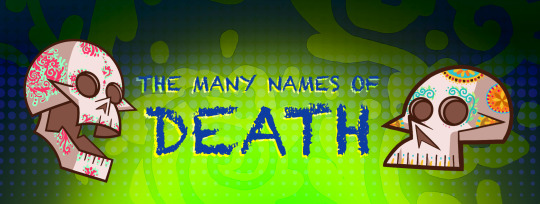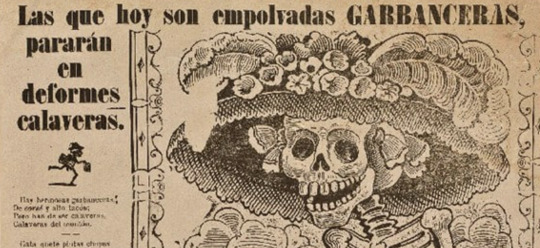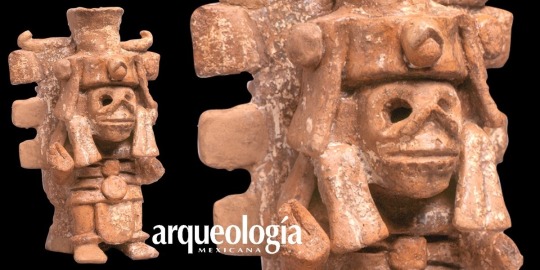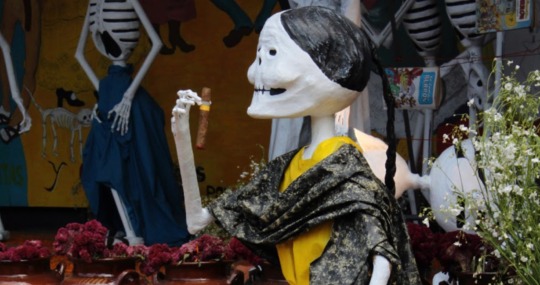#dayothe(half)dead
Explore tagged Tumblr posts
Text

The Many Names of Death (in México)
(banner images by @andrei-skelepina)
Her most well-known name is “La Catrina”, an elegant, upper-class lady, wearing a hat full of feathers to represent the social inequality rampant in the early 1910s when José Guadalupe Posada drew her (“La Calavera Garbancera”, had been her real name at first [Source ESP / ENG]). But from then on, this identity became forever associated with Death. La Muerte.

She takes you whether you’re rich or poor, “good” or “evil”, it doesn’t matter. Whatever we built in life stays in the world of the living, as we take nothing to our graves. Hence why she’s “La Igualadora” or “La Democrática” because she evens any ridiculous score you thought you had in life.
How funny these names came from a more modern era when the Nahuas/Mexicas believed anyone who died a natural death could liberate their soul after several trials to the Lord and Lady of Death (Mictlantecuhtli & Mictecacíhuatl) to acquire a new form of existence in the underworld, in the Mictlán. (Source ESP / ENG)

But despite Death being amoral, uninterested in what we did in life, it doesn’t mean she doesn’t enjoy a good chase in later representations. She’s now shown as someone to run away from, to deceive, to escape. In the end, the game always ends the same. Her thin and bony appearance is seen often in poems (as we mentioned in our Calaveritas post here) dedicated to her cunning, soul-hunting skills. But don’t be fooled: “La Calaca Tilica y Flaca” (the frail, skinny skeleton) is anything but weak.
The hairless skull gave her the name of “La Pelona” or “La Calva” (the bald one), while others wrote odes to her lack of teeth, calling her “La Chimuela” or “La Sin Dientes” as names that reveal her toothless smile. Others steer away from her stench, foul and rotten. “La Apestosa” or “La Hedionda” (the smelly one) they’ll call her while giving her the stink eye.
And again these newer denominations don’t steer too far from older roots and sound similar to how the Mayans from Yucatán referred to Ah Puch as “The Stinky one”, one of the names of the lord of death and disease, ruler of Xibalbá (the underworld… yes, Xibalbá is a place, not a deity) [Source: ESP / ENG)

But now we don’t talk about trials and tribulations, though we do talk about Death in our everyday struggles. “La Chingada” or “La Fregada” (the ruined one) we say colloquially when we feel like it takes us to a darker place when things are not going our way. (“Me lleva la chingada”, “me siento de la fregada”, we exclaim even when something gone wrong won’t call for our real demise.) We even have sayings such as “no hay que cargar con el muerto” when we don’t want to carry an old burden.
To die can be to “petatearse” (lay to rest on a petate or resting mat), to “chupar faros” (take a smoke before being shot), we say someone “(lo/la/le) cargó el payaso” (was carried by the clown, as riders in the rodeo when they got hit by the bull); someone who dies, “estiró la pata” (stretched a rigid foot), “colgó los tenis” (hung their sneakers on the lightpost cables, as people do when someone dies in some neighborhoods), or “felpó” (to refer to torn clothing).
But death can be treated as something more respectful, with fancier names: “La Dama de la Guadaña” (the Lady of the Scythe), “Doña Huesos” (Mrs. Bones), “Doña Osamenta” (Mrs. Skull), while there’s some room to show affection: “La Amada Inmóvil” (the still lover), “La Malquerida” (the badly-loved one) or “La Niña Blanca” (the white little girl).
There’s plenty of respect and some even call her the Santa Muerte (Holy Death), adoring her like a saint, asking for favors, for protection, and honoring her in many ways, mainly in barrios like Tepito in which she even has shrines and temples dedicated to her. (Source ESP / ENG)
No matter what we call her, how we portray her in art or poetry, how our sayings or legends go, there’s this sense of familiarity with Death, as if she were someone we’ve always known and can invite for a drink or have a nice chat with, goof around, show your sorrows.
In the end, as we say “Al diablo la muerte mientras nos dure la vida.” (To hell with death while life lasts.)

#day of the (half) dead#día de (medio) muertos#day of the dead#día de muertos#dia de muertos#díade(medio)muertos#dayothe(half)dead#inspiration for the danny phantom event#mexico
96 notes
·
View notes